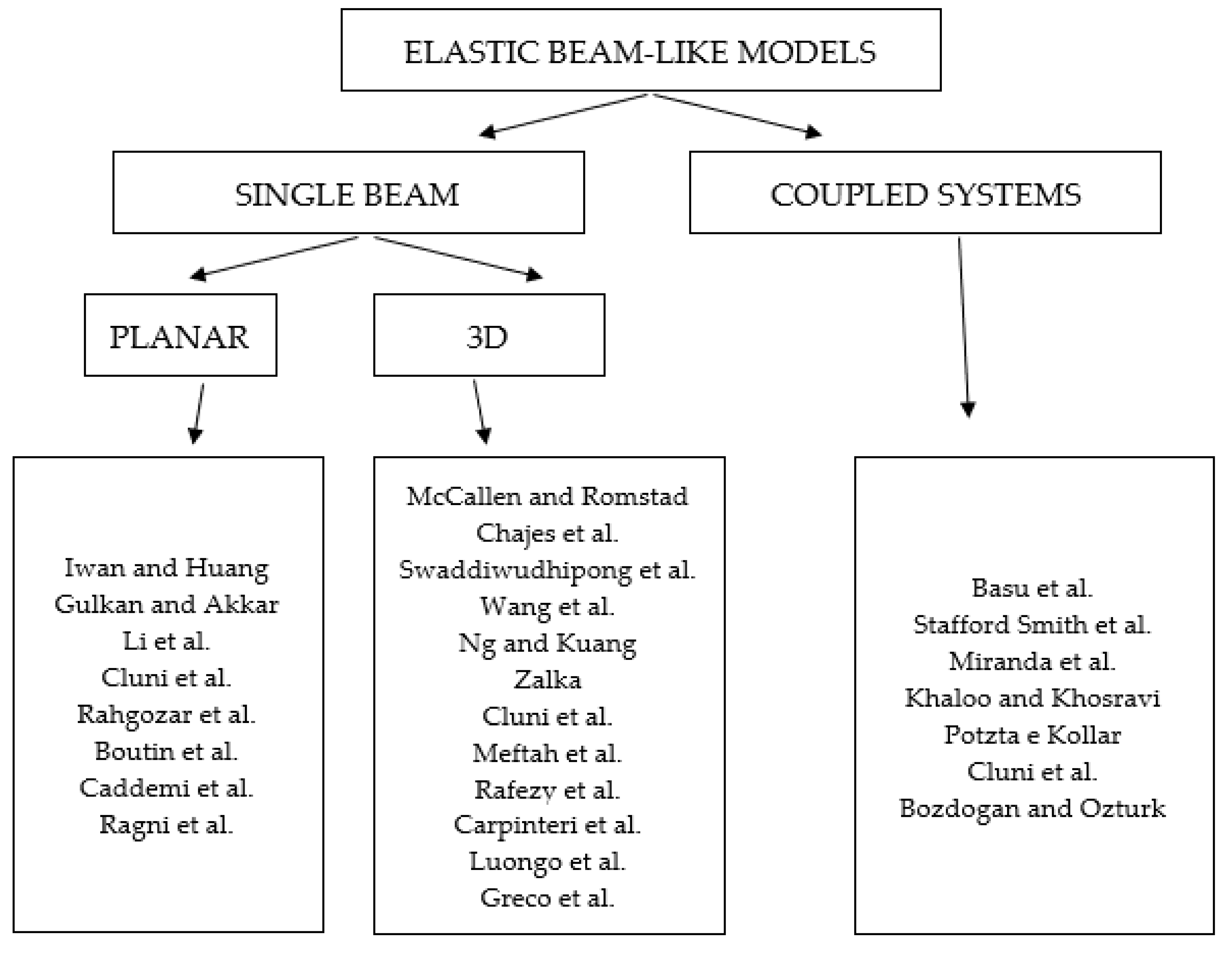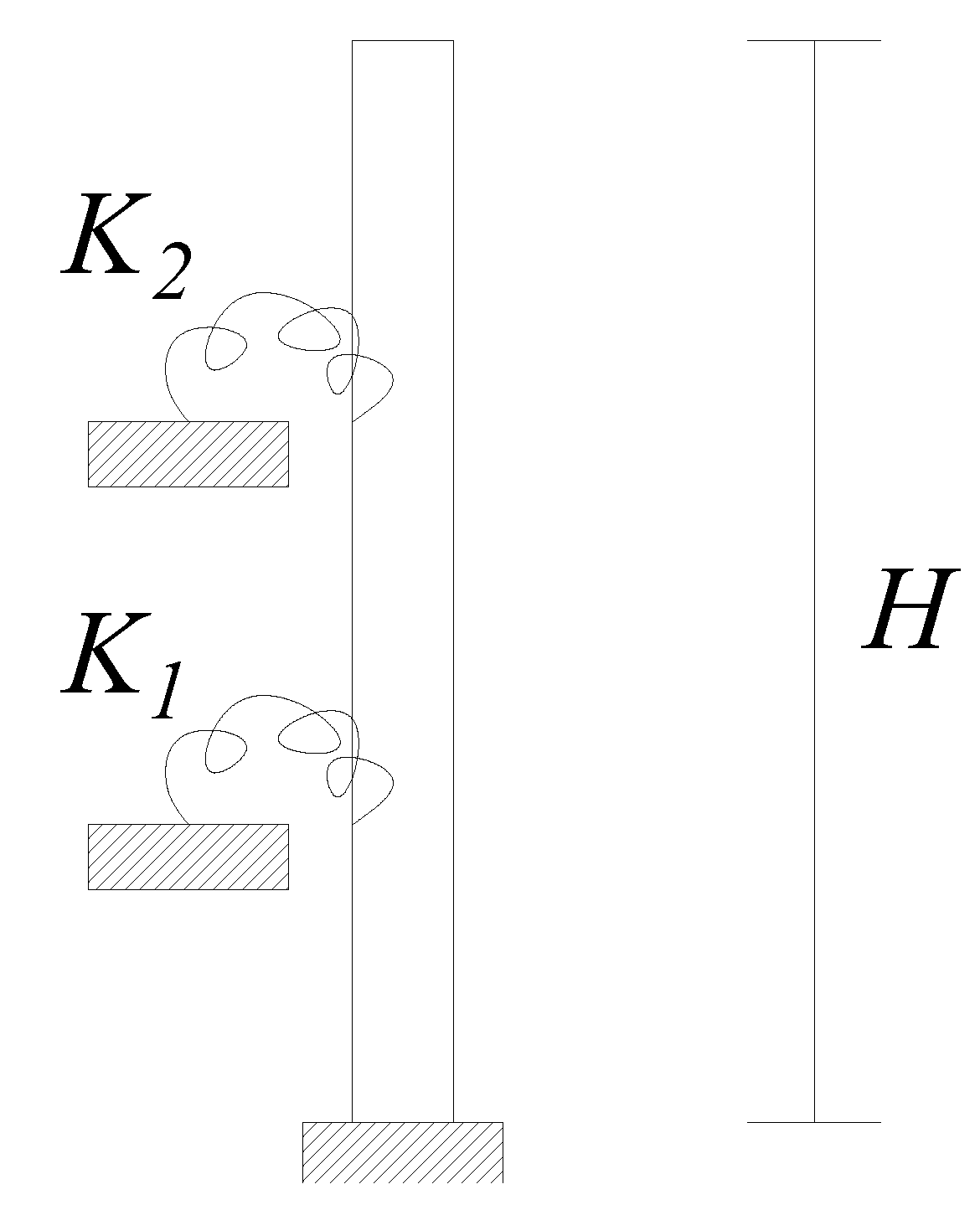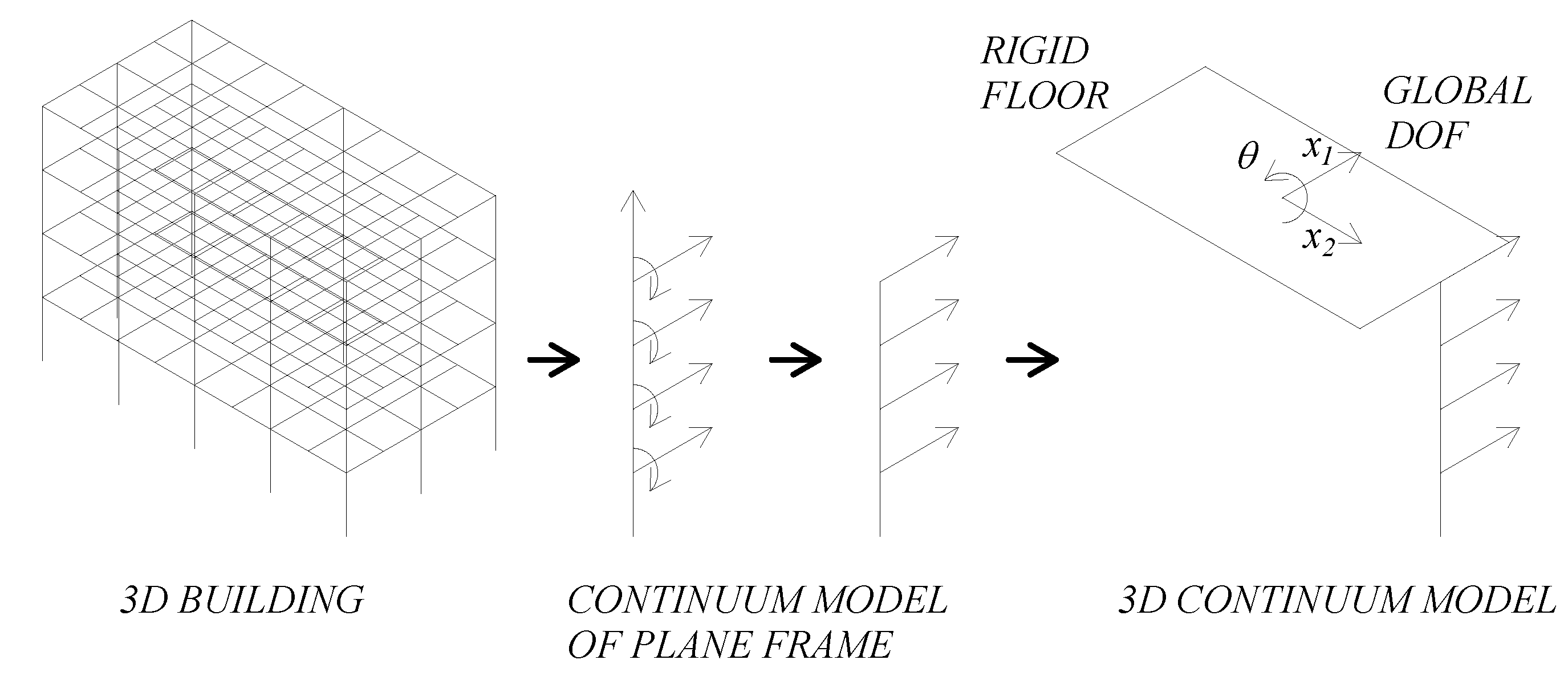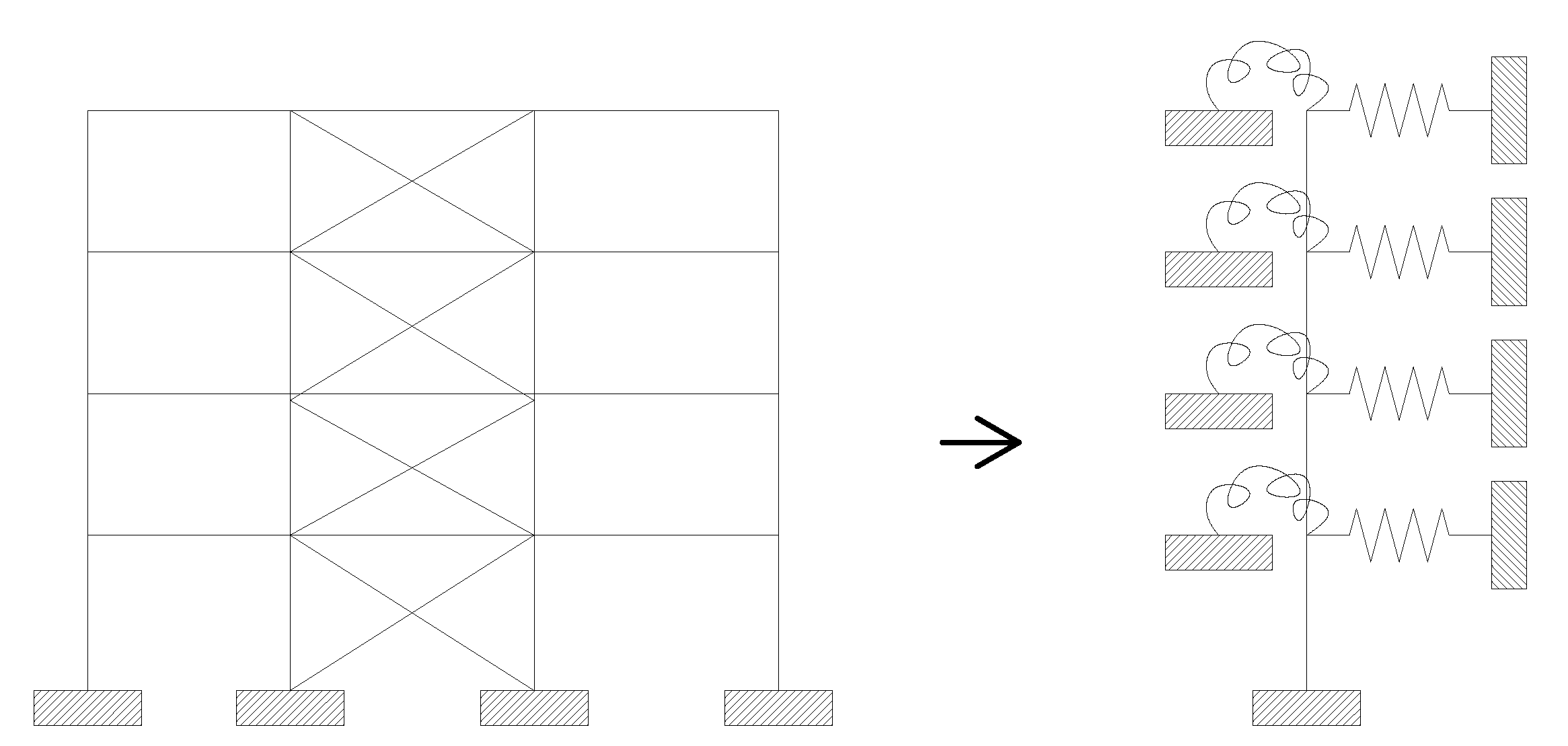Please note this is a comparison between Version 2 by Rita Xu and Version 1 by Ilaria Fiore.
Modern computational techniques have greatly influenced the numerical analyses of structures, not only in terms of calculation speed, but also in terms of procedural approach. In particular, great importance has been given to structural modelling, that is, the process by which a structure and the actions to which it is subjected are reduced to a simplified scheme. The use of a simplified calculation scheme is necessary since the structures are, in general, considerably complex physical systems whose behaviour is influenced by a large number of variables.
- modelling of framed structures
- multi-storey buildings
- beam-like models
- elastic models
1. Introduction
The evaluation of the dynamic response of multi-storey buildings, particularly when subjected to seismic loading, has represented one of the most important tasks of structural engineering research studies in the last century, and is still the objective of studies and improvements. The advancements in computational procedures and parallel processing in the recent years have enhanced the accurate dynamic analysis and seismic vulnerability of multi-storey buildings. These analyses can be carried out at the building or urban level; simplified or high-fidelity models, as well as approximate or sophisticated large-scale simulations, are currently adopted. However, when analysing entire urban areas or when performing several simulations aiming to provide sufficient data for expressing probability failure maps, a convenient balance between accuracy and computational burden is needed. In this precise context, beam-like models play an important role.
Analyses developed by means of three-dimensional (3D) numerical models aim to provide an accurate representation of the main characteristics of the dynamic behaviour of real structures and, for this reason, must be detailed and based on reliable data. Therefore, a rigorous and accurate evaluation of the dynamic response of a multi-storey building subjected to seismic excitation requires adequate structural expertise and great computational burden. On the other hand, the need for a sufficiently accurate seismic vulnerability assessment of a large number of existing buildings in seismic areas, in particular at an urban scale, has stimulated a significantly increased interest in simplified but sufficiently accurate models able to represent multi-storey buildings.
Since multi-storey buildings may exhibit a great number of degrees of freedom, especially if several deformability parameters of the structural members are taken into account, simplified multi-degree-of-freedom (MDOF) models are usually considered. In this regard, some models have been presented in the scientific literature for the simulation of linear as well as non-linear dynamic responses of multi-storey buildings. The most important goal of these simplified models is to reduce the number of degrees of freedom of the 3D model, preserving the main features of its dynamic response.
A new and renovated interest has recently grown in beam-like models, which were introduced in the last century. Beam-like models, which are based on the equivalence of multi-level structures to flexural–shear coupling continuum beams, aim to simulate the dynamic behaviour of multi-level buildings and meanwhile reduce the computational burden. Several authors have demonstrated interest in beam-like models and proposed suitable simplified approaches for the dynamic analysis of multi-storey structures.
2. Elastic Beam-like Models
The analysis of multi-storey buildings has been performed in recent decades by means of equivalent beam-like models. These models are represented by continuum mono-dimensional elements whose static and dynamic responses are strictly related to the assumed hypotheses concerning their geometry, their deformability, the material behaviour and the kind of developed analysis (linear or non-linear). Most of the studies in the scientific literature concerning beam-like models deal with elastic behaviour. Each of these models aim to reproduce the static or dynamic response of complex structures, taking into account their prevailing elastic deformability. Therefore, different beam-like models having shear-only, flexural-only or coupled shear–flexural deformability are reviewed and discussed below. Some beam-like models are equivalent to plane structures, whilst others are able to represent the three-dimensional behaviour of a building. The presence of twisting effects may or may not be considered. All these characteristics of the beam-like models lead to different choices of the degrees of freedom in order to define a system able to reproduce the investigated behaviour with the established kinematics. The approaches also differ in the assumption hypothesis about the mass of the models which can be concentrated or distributed along the beam. The main advantage of some beam-like models present in the literature is their adoption for the study of the static or dynamic behaviour of real buildings, as shown in the applicative section of the following cited papers. Furthermore, beam-like models can be base-isolated systems or include soil–structure interaction by means of an appropriate modelling of the base restraints. Several classifications can be made in the attempt to illustrate the great number of scientific contributions in this field. In the following, wresearchers choose to classify the scientific literature by separating the models of a single equivalent beam from those in which beams with different characteristics are coupled to each other, or in which single beams are coupled to walls or frames. For the first category, a further distinction will be made between planar and three-dimensional systems. The adopted classification has been graphically illustrated in Figure 1.
Figure 1. Classification of elastic beam-like models.
2.1. Single Beams
2.1.1. Planar Systems
Among the studies concerning planar beam-like structures presented in the scientific literature in the last 50 years, one of the first ones was developed by Iwan [1] and Huang [2], who proposed a continuous uniform shear–beam model to predict elastic storey drift demand on structures due to near-field earthquake ground motions. Noticing that the continuous model predicts the inter-storey drifts more accurately than an equivalent single-degree-of-freedom (SDOF) system, they suggested the use of a drift spectrum instead of the well-known response spectrum. The evaluation of the maximum inter-storey drifts of a building by means of the first-mode shape of a uniform shear beam was the aim of a later study proposed by Gulkan and Akkar [3]. In 2005, they modified the equivalent shear beam model in order to take into account the general moment-resisting frame (MRF) behaviour of the structure by introducing some empirical coefficients into the maximum ground storey and inter-storey drift expressions [4]. Beam-like structures, due to their inherent characteristics, have great application in modelling tall buildings. The in-plane free vibration of tall buildings was studied in 2000 by Li et al. [5] by means of an equivalent flexural multi-step cantilever beam with stiffness, mass and axial loads distributed according to a power or exponential law of variation. The approximated solution of this complex problem was obtained using the exact solution of a one-step bar with a variable cross-section together with the transfer matrix method. This approach was extended in [6] by Rahgozar et al. for an equivalent Timoshenko multi-step beam, and in [7] for a sandwich beam, the latter defined according to Zalka’s, Potza’s and Kollar’s approach described in the following. Additionally, Cluni et al. adopted two equivalent beam models for studying the dynamic response of tall buildings under wind loads [8]. The equivalent beam models had uniform flexural and shear stiffness, linked together in series or in parallel. The equivalence criterion was based on the minimization of the difference of static and dynamic response features obtained by means of the equivalent beam and the FEM model. The mechanical parameters used to describe the beam varied sensibly with respect to the real ones, but the main interest was to find an equivalent beam which could accurately describe the response of the slender building, regardless of any physical meaning. In 2020, the model was extended in order to describe the flexural, shear and torsional behaviour of uniform tall buildings with an asymmetrical plan subjected to wind or earthquake loads [9]. The mechanical and dynamic features of the equivalent beam were first evaluated, imposing the equivalence of the deformation energy between the equivalent sandwich beam and the sub-structures of the tall building, and then calibrated by minimizing a function which takes into account natural frequencies and static displacements. The limitation of this model consists of its unsuitability in representing asymmetrical buildings. The results of the analyses performed on regular and symmetrical buildings with uniform stiffness distribution are shown in terms of natural frequencies and mode shapes and in terms of displacements under static or dynamic wind or earthquake loads. Tall buildings were also modelled by means of an equivalent beam by Rahgozar et al. in 2010. Basing the study on previous research [10], they proposed a continuum model for predicting the stress distribution and the displacement profile for a combined system of different structural elements, but only under specific load patterns [11]. The model consisted of an equivalent uniform cantilever beam with flexural and shear deformability and rotational springs simulating the belt trusses (Figure 2). This model was applied to estimate the natural frequencies and mode shapes of the tall buildings [12[12][13],13], obtaining acceptable errors if compared to finite element models.
Figure 2. Schematization of the equivalent beam model proposed by Rahgozar et al.
2.1.2. Three-Dimensional Systems
One of the pioneering studies concerning the use of three-dimensional beam-like structures for the analysis of buildings has been provided by McCallen and Romstad. In [22[22][23],23], they proposed a simple uniform continuum model for the analysis of lattice structures (which are repetitive reticular structures). The equivalence between the lattice structure and the continuum model was established in terms of deformation energies for three assumed global deformation modes (axial, shear, bending). The continuum model was then analysed by means of a traditional finite element approach. Geometrical non-linearities are accounted for through updated Lagrangian coordinate transformation for each continuum finite element. The translational and rotational inertias are lumped at the end or midpoint nodes of the finite elements of the discretised continuum. The approach was extended to three-dimensional buildings with rigid floors. Therefore, the global model has only three degrees of freedom, two orthogonal translations and one rotation at each floor level. By applying horizontal forces only, the rotational and axial degrees of freedom of the continuum can be condensed out. Later, the condensed continuum model of an individual frame can be transformed to global coordinates and added into the global stiffness (Figure 3).
Figure 3. Construction of a 3D building model using continuum models for each plane frame according to McCallen and Romstad.

Figure 4. Model for lateral vibration analysis according to Zalka: (a) bracing system consisting of frames, coupled shear walls, shear walls and cores; (b) equivalent column.

Figure 5. Model of a braced frame equivalent to a shear wall according to Carpinteri et al.

Figure 6. Concept of representation starting from (a) the 3D structure and (b) the generic k-th floor (or inter-storey) up to the (c) sub-beam element and the (d) proposed beam-like model. Source: own figure [58].
References
- Iwan, W.D. Drift spectrum: Measure of demand for earthquake ground motions. J. Struct. Eng. 1997, 123, 397–404.
- Huang, C.T. Considerations of multimode structural response for near-field earthquakes. J. Eng. Mech. 2003, 129, 458–467.
- Gulkan, P.; Akkar, S. A simple replacement for the drift spectrum. Eng. Struct. 2002, 24, 1477–1484.
- Akkar, S.; Yazgan, U.; Gulkan, P. Drift estimates in Frame Buildings Subjected to Near-Fault Ground Motions. J. Struct. Eng. 2005, 131, 1014–1024.
- Li, Q.S.; Fang, J.Q.; Jeary, A.P. Free vibration analysis of cantilevered tall structures under various axial loads. Eng. Struct. 2000, 22, 525–534.
- Rahgozar, R.; Safari, H.; Kaviani, P. Free vibration of tall buildings using Timoshenko beams with variable cross-section. In Structures under Shock and Impact VIII; WIT Press: Southampton, UK, 2004; pp. 233–242.
- Kaviani, P.; Rahgozar, R.; Saffari, H. Approximate analysis of tall buildings using sandwich beam models with variable cross section. Struct. Des. Tall Spec. Build. 2008, 17, 401–418.
- Cluni, F.; Gioffrè, M.; Gusella, V. Dynamic response of tall buildings to wind loads by reduced order equivalent shear-beam models. J. Wind Eng. Ind. Aerodyn. 2013, 123 Pt B, 339–348.
- Gioffrè, M.; Cluni, F.; Gusella, V. Characterization of an Equivalent Coupled Flexural-Torsional Beam Model for the Analysis of Tall Buildings under Stochastic Actions. J. Struct. Eng. 2020, 146, 04020239-1.
- Kwan, A. Simple method for approximate analysis of framed tube structures. J. Struct. Eng. ASCE 1994, 120, 1221–1239.
- Rahgozar, R.; Ahmadi, A.; Sharifi, Y. A simple mathematical model for approximate analysis of tall buildings. Appl. Math. Model. 2010, 34, 2437–2451.
- Malekinejad, M.; Rahgozar, R. A simple analytic method for computing the natural frequencies and mode shapes of tall buildings. Appl. Math. Model. 2012, 36, 3419–3432.
- Malekinejad, M.; Rahgozar, R. An analytical model for dynamic response analysis of tubular tall buildings. Struct. Des. Tall Spec. Build. 2014, 23, 67–80.
- Boutin, C.; Hans, S. Homogenisation of periodic discrete medium: Application to dynamics of framed structures. Comput. Geotech. 2003, 30, 303–320.
- Hans, S.; Boutin, C. Dynamics of discrete framed structures: A unified homogenized description. J. Mech. Mater. Struct. 2008, 3, 1709–1739.
- Chesnais, C.; Boutin, C.; Hans, S. Effects of the local resonance in bending on the longitudinal vibrations of the reticulated beams. Wave Motion 2015, 57, 1–22.
- Franco, C.; Chesnais, C.; Semblat, J.-F.; Giry, C.; Desprez, C. Finite element formulation of a homogenized beam for reticulated structure dynamics. Comput. Struct. 2022, 261–262, 106729.
- Franco, C.; Chesnais, C.; Semblat, J.-F.; Desprez, C.G.C. Seismic analysis of tall buildings through an enriched equivalent beam model: Application to Grenoble City Hall. In Proceedings of the 3rd European Conference on Earthquake Engineering & Seismology, Bucharest, Romania, 4–9 September 2022.
- Caddemi, S.; Caliò, I.; Cannizzaro, F.; Rapicavoli, D. A novel beam finite element with singularities for the dynamic analysis of discontinuous frames. Arch. Appl. Mech. 2013, 83, 1451–1468.
- Caddemi, S.; Caliò, I. The exact explicit dynamic stiffness matrix of multi-cracked Euler-Bernoulli beam and applications to damaged frame structures. J. Sound Vib. 2013, 332, 3049–3063.
- Ragni, L.; Zona, A.; Dall’Asta, A. Analytical expressions for preliminary design of dissipative bracing systems in steel frames. J. Constr. Steel Res. 2011, 67, 102–113.
- McCallen, D.; Romstad, K.M. Application of a Continuum Model in Building Analysis. In Proceedings of the “Buildings Structures” Proceedings Structures Congress ‘87, Orlando, FL, USA, 17–20 August 1987.
- McCallen, D.B.; Romstad, K.M. A continuum model for the nonlinear analysis of beam-like lattice structures. Comput. Struct. 1988, 29, 177–197.
- Chajes, M.; Romstad, K.; McCallen, D. Analysis of multiple-bay frames using continuum model. J. Struct. Eng. ASCE 1993, 119, 522–546.
- Chajes, M.; Finch, W.; Kirby, J. Dynamic analysis of a ten-story reinforced concrete building using a continuum model. Comput. Struct. 1996, 58, 487–498.
- Chajes, M.; Zhang, L.; Kirby, J. Dynamic analysis of tall building using reduced-order continuum model. J. Struct. Eng. ASCE 1996, 122, 1284–1291.
- Swaddiwudhipong, S.; Lee, S.-L.; Zhou, Q. Effect of axial deformation on vibration of tall buildings. Struct. Des. Tall Build. 2001, 10, 79–91.
- Swaddiwudhipong, S.; Soelarno Sidji, S.; Lee, S.-L. The effects of axial deformation and axial force on vibration characteristics of tall buidings. Struct. Des. Tall Build. 2002, 11, 309–328.
- Wang, Y.; Arnaouti, C.; Guo, S. A simple approximate formulation for the first two frequencies of asymmetric wall-frame multi-storey building structures. J. Sound Vib. 2000, 236, 141–160.
- Ng, S.; Kuang, J.S. Triply coupled vibration of asymmetric wall-frame structures. J. Struct. Eng. 2000, 126, 982–987.
- Kuang, J.S.; Ng, S. Dynamic coupling of asymmetric shear wall structures: An analytical solution. Int. J. Solids Struct. 2001, 38, 8723–8733.
- Kuang, J.S.; Ng, S. Coupled vibration of tall building structures. Struct. Des. Tall Spec. Build. 2004, 13, 291–303.
- Kuang, J.S.; Ng, S. Lateral shear-St. Venant torsion coupled vibration of asymmetric-plan frame structures. Struct. Des. Tall Spec. Build. 2009, 18, 647–656.
- Zalka, K. A simplified method for calculation of the natural frequencies of wall-frame buildings. Eng. Struct. 2001, 23, 1544–1555.
- Zalka, K. A simple method for the deflection analysis of tall wall-frame building structures under horizontal load. Struct. Des. Tall Spec. Build. 2009, 18, 291–311.
- Zalka, K. Maximum deflection of asymmetric wall-frame buildings under horizontal load. Period. Polytech. Civ. Eng. 2014, 58, 387–396.
- Meftah, S.A.; Tounsi, A.; El Abbas, A.B. A simplified approach for seismic calculation of a tall building braced by shear wall and thin-walled open section structures. Eng. Struct. 2007, 29, 2576–2585.
- Meftah, S.A.; Tounsi, A. Vibration charateristics of tall buildings braced by shear walls and thin-walled open section structures. Struct. Des. Tall Spec. Build. 2008, 17, 203–216.
- Rafezy, B.; Zare, A.; Howson, W.P. Coupled lateral-torsional frequencies of asymmetric, three-dimensional frame structures. Int. J. Solids Struct. 2007, 44, 128–144.
- Rafezy, B.; Howson, W.P. Vibration analysis of doubly asymmetric, three-dimensional structures comprising wall and frame assemblies with variable cross-section. J. Sound Vib. 2008, 318, 247–266.
- Carpinteri, A.; Lacidogna, G.; Cammarano, S. Structural analysis of high-rise buildings under horizontal loads: A study on the Intesa Sanpaolo Tower in Turin. Eng. Struct. 2013, 56, 1362–1371.
- Carpinteri, A.; Lacidogna, G.; Nitti, G. Open and closed shear-walls in high-rise structural systems: Static and dynamic analysis. Curved Layer. Struct. 2016, 3, 154–171.
- Nitti, G.; Lacidogna, G.; Carpinteri, A. Structural analysis of high-rise buildings under horizontal loads: A study on the Piedmont Region Headquarters tower in Turin. Open Constr. Build. Technol. J. 2019, 13, 81–96.
- Piccardo, G.; Tubino, F.; Luongo, A. A shear-shear torsional beam model for nonlinear aeroelastic analysis of tower buildings. J. Appl. Math. Phys. 2014, 66, 1895–1913.
- Sciomenta, M.; Luongo, A. Linear dynamic analysis of multistore tower buildings via an equivalent shear-shear torsional beam model. In Proceedings of the XXIII Conference of the Italian Association of Theoretical and Applied Mechanics, Salerno, Italy, 4–7 September 2017.
- Piccardo, G.; Tubino, F.; Luongo, A. Equivalent nonlinear beam model for the 3-D analysis of shear-type buildings: Application to aeroelastic instability. Int. J. Non-Linear Mech. 2015, 80, 52–65.
- Di Nino, S.; Luongo, A. Nonlinear aeroelastic behaviour of a base-isolated beam under steady wind flow. Int. J. Non-Linear Mech. 2020, 119, 103340.
- D’Annibale, F.; Ferretti, M.; Luongo, A. Shear-shear-torsional homogenous beam models for nonlinear periodic beam-like structures. Eng. Struct. 2019, 184, 115–133.
- Luongo, A.; Zulli, D. Free and forced linear dynamics of a homogeneous model for beam-like structures. Meccanica 2020, 55, 907–925.
- Piccardo, G.; Tubino, F.; Luongo, A. Equivalent Timoshenko linear beam model for the static and dynamic analysis of tower buildings. Appl. Math. Model. 2019, 71, 77–95.
- Ferretti, M.; D’Annibale, F.; Luongo, A. Modeling beam-like planar structures by a one-dimensional continuum: An analytical-numerical method. J. Appl. Comput. Mech. 2021, 7, 1020–1033.
- D’Annibale, F.; Ferretti, M.; Luongo, A. Static and Dynamic Responses of Micro-Structured Beams. Appl. Sci. 2020, 10, 6836.
- Luongo, A.; D’Annibale, F.; Ferretti, M. Shear and flexural factors for static analysis of homogenized beam models of planar frames. Eng. Struct. 2021, 228, 111440.
- Ferretti, M.; D’Annibale, F.; Luongo, A. Buckling of tower buildings on elastic foundation under compressive tip forces and self-weight. Contin. Mech. Thermodyn. 2020.
- Zulli, D.; Luongo, A. Nonlinear dynamics and stability of a homogeneous model of tall buildings under resonant action. J. Appl. Comput. Mech. 2021, 7, 1034–1048.
- Di Nino, S.; Luongo, A. Nonlinear dynamics of a base-isolated beam under turbulent wind flow. Nonlinear Dyn. 2022, 107, 1529–1544.
- Luongo, A. Statics, Dynamics, Buckling and Aeroelastic Stability of Planar Cellular Beams. In Modern Trends in Structural and Solid Mechanics 2: Vibrations; ISTE, Ltd.; John Wiley & Sons, Inc.: Hoboken, NJ, USA, 2021; pp. 143–165.
- Greco, A.; Fiore, I.; Occhipinti, G.; Caddemi, S.; Spina, D.; Caliò, I. An Equivalent Non-Uniform Beam-Like Model for Dynamic Analysis of Multi-Storey Irregular Buildings. Appl. Sci. 2020, 10, 3212.
More
 Encyclopedia
Encyclopedia
